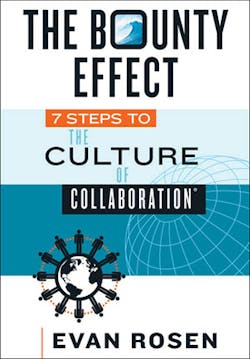Despite new technologies and process improvements, collaboration is dead on arrival for many companies. This is because the structure of many organizations has barely changed since the Industrial Age. Command-and-control defined Industrial Age organizational structure, and remnants of this structure remain embedded in organizations.
Companies operating in command-and-control mode pay a few people to think and pay everybody else to carry out orders. Ideas and information get stuck in silos, and we lose opportunities to develop better ideas, make better decisions, manufacture better products and create new markets.
My new book, The Bounty Effect: 7 Steps to The Culture of Collaboration, focuses on how to shift the structure of an Industrial Age command-and-control organization to an Information Age collaborative structure. Based on the book, here are 5 ways a manufacturing company can adopt a more collaborative structure:
Establish All-Access People Policy
Technology lets us interact with anybody on the fly regardless of level, role or region. But organizational structure and culture often lag behind this capability. Adopting an All-Access People Policy means everybody has immediate access to everybody else regardless of level, role or region. Plus team members have the organization’s blessing to use this access whenever necessary. The technology enhancing this shift is unified communications. With UC, people can easily view each other’s availability, see one another’s location and connect spontaneously through instant messaging, voice, web conferencing, videoconferencing and telepresence.
Without an All-Access People Policy, information can get lost or buried—sometimes with devastating consequences. If NASA and its contractors had an All-Access People Policy, the space shuttle Challenger disaster might have been averted. Roger Boisjoly, an engineer at Morton Thiokol, warned in a 1985 memo to the company’s vice president of engineering that seals on Challenger’s booster rocket joints could fail. Despite the memo and other warnings, managers at Morton Thiokol gave NASA the okay to launch Challenger. Seventy-three seconds into its flight, Challenger broke apart and disintegrated over the Atlantic Ocean. All seven crew members died, because the seals on the booster rocket joints failed as Boisjoly had warned.
Suppose Roger Boisjoly had felt empowered to share his concerns with Morton Thiokol’s CEO or NASA senior leaders without going through channels? What if senior leaders of Morton Thiokol had valued Boisjoly’s input? Suppose key information had traveled beyond a silo? And what if there were a mechanism to share and access input and concerns spontaneously across the space program? The results for the Challenger team may have been different.
Design Collaborative Workspaces
Physical and cultural barriers provide lingering reminders of the Industrial Age during which command-and-control inhibited people from interacting across levels, roles and regions. One approach to breaking down barriers and enhancing collaboration is designing collaborative workspaces. Most change, though, requires a trigger—and that’s where The Bounty Effect has an impact.
The Bounty Effect happens when exigent circumstances compel companies to change their structures from command-and-control to collaborative. For Boeing, the Bounty Effect occurred when a 6.8 magnitude earthquake hit Renton, Washington on February 28, 2001. With the building housing fourteen hundred 737 engineers nearly flattened, the company seized the opportunity to break down barriers. Boeing relocated the engineers to vacant space in the 737 plant. Traditionally, the plant was a “no-go zone” for some engineers who embraced their “white-collar” status.
Boeing worked with Steelcase to encourage cultural shift through design. Now Boeing engineers work in open spaces along the 737 plant’s mezzanine. Mechanics, engineers, leaders and production team members interact frequently and spontaneously on a wide “boardwalk” adjacent to mezzanine workspaces. So in redesigning the physical workspace, Boeing also redesigned relationships by breaking down Industrial Age barriers between engineers and manufacturing team members.
Collaborate with Customers
Innovative companies collaborate beyond organizational borders. The Lego Group has created stickier products by engaging customers for co-creation. Before the late 1990s, Lego operated in command-and-control mode by refusing to accept “unsolicited” ideas. Then came Lego Mindstorms, which included software and hardware to create small programmable and customizable robots. More technically-savvy users hacked the code and changed the products. Rather than sue these customers, Lego decided to collaborate with them. Since then, Lego users have collaborated with team members to create new product lines and distribution channels. Lego also uses revenue sharing to create incentives for customers.
Collaborate with Competitors
Collaborating with competitors works best for eliminating redundancy in non-differentiating processes. These are typically under-the-hood processes that are not part of a company’s market or product perception. Two companies that each make hot sauce might use the same bottling equipment. Two newspapers in the same market might use the same printing presses. Entire industries participate in consortiums for purchasing, saving each competing company substantial money. These shared, non-differentiating processes are invisible to the customer.
Engines are invisible to all but the most die-hard car enthusiasts, so collaborating on this process arguably fits the bill as non-differentiating. This year Toyota reportedly expects to sell 44,000 Verso compact minivans in Europe. These minivans include 1.6-liter diesel engines sourced from Toyota’s competitor, BMW. The two automakers are also collaborating on developing fuel cell systems and lightweight vehicle body technologies among other projects.
5) Create Mirror Zones
Companies can create incredible value by exploiting time zone differences. Mirror zones are time zones that are either opposite or nearly opposite. In collaborative manufacturing, a mirror team works in each mirror zone. Each team member on a mirror team shares a job with his or her counterpart on the opposite mirror team. When Mirror Team A sleeps, Mirror Team B works. This creates a near 24-hour product design and development environment. Schedules can be staggered so that shifts overlap by a couple of hours, giving counterparts an opportunity to collaborate in real time. The rest of the time, collaboration happens asynchronously. Mirror zones reduce time to market and time to goal in industries including aerospace, automotive, consumer products, healthcare, pharmaceutical, digital effects and many others.
Evan Rosen is an internationally-recognized collaboration and communication strategist. He is author The Bounty Effect: 7 Steps to The Culture of Collaboration. He is also author of The Culture of Collaboration.





